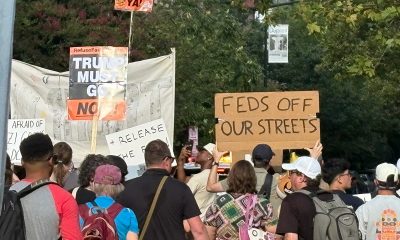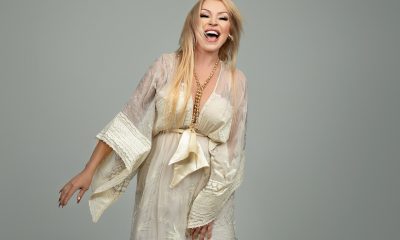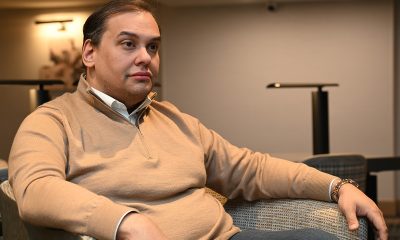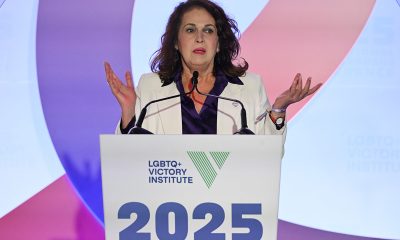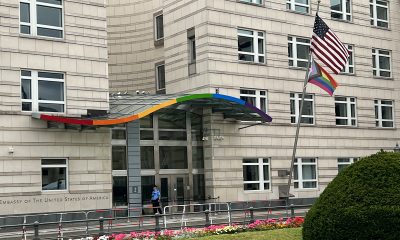a&e features
Fringe Festival rich with LGBT themes
A male pop star, Galactica and more on this year’s slate
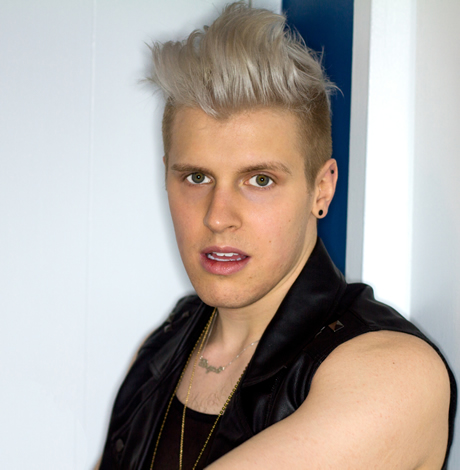
Growing up in the suburbs of Pittsburgh, Bryce Sulecki admired the likes of Britney Spears, Lady Gaga and Madonna. While their support of the gay community comforted him, he couldn’t help but feel that there was an absence.
“There was this voice missing,” says Sulecki, who graduated from American University’s prestigious musical theater program in 2015. “From a gay male pop star.”
Sulecki longed to hear a performer directly singing about gay relationships, struggles and even everyday life with the same type of choreography, costumes and theatrics that had inspired him as a child.
Sulecki decided to take matters into his own hands and create the gay pop star he’d been searching for, but he needed an outlet, which he found in the D.C. Capital Fringe Festival.
The Capital Fringe Festival, which just opened and runs through July 31, is a nonprofit organization founded in 2005 by Julianne Brienza and Damien Sinclair. Capital Fringe focuses on bolstering opportunities for audiences to view independent, off-the-beaten-path theater, music, dance and other forms of performance and visual art.
Fringe festivals began in 1947 as an alternative to the Edinburgh International Festival in Edinburgh, Scotland. The festival has since expanded its presence all over the world to countries such as Australia, Canada, the United Kingdom and the United States.
Capital Fringe has become the second largest Fringe Festival in the United States. As of 2015, it had generated $1.7 million for artists, featured more than 600 new productions and generated 886 paid jobs. Roughly 130 shows are featured in the Capital Fringe festival each year.
A spot in Fringe is determined on a first-come, first-served basis by submitting proposals for shows online. Capital Fringe provides the venue for accepted plays and handles the main marketing to promote the shows. The playwright is in charge of all other fees, including costumes, payment to cast, crew and the director and any other costs.
The festival prides itself on its focus of the performing arts community as a whole, rather than just promoting the work of an individual.
With this mission, it’s no wonder that in its 11th year Capital Fringe 2016 will feature a diverse range of LGBT productions, including Sulecki’s interactive-pop-concert- extravaganza, “Bryce: Hydrogen Blonde,” in which he is the producer, co-writer and star.
“I think that [the] most meaningful part of the experience is seeing my own work in front of an audience,” Sulecki says. “I keep getting chills just thinking about it.”
Themes this year touch on a variety of LGBT issues.
Kevin West, an out playwright and director of “The DOMA Diaries,” wants to reveal the struggles and obstacles that the Defense of Marriage Act created in the lives of LGBT couples. While the play is a work of fiction, it is based on real-life experiences.
The play also includes a fictional adaptation of West’s own struggle being part of a bi-national couple. West constantly feared that his then-partner (now husband) would be forced to return to his country of origin, as West could not sponsor him for a green card under DOMA’s restrictions.
“There’s a funny scene in which a gay couple goes to a Mailboxes Etcetera to have their domestic partnership documents notarized, and they treat the event like a mini-wedding,” West says. “Since gay marriage isn’t yet legal, and may never be, they realize that this mundane event is the closest they will ever come to a wedding ceremony.”
One of the stars of the play, Nell Quinn-Gibney, a 20-year-old senior at the University of Maryland, Baltimore County, who was raised by a lesbian couple and was present outside the Supreme Court when the DOMA decision was announced, says she never fully understood the impact of the act until she began working on the show.
“Reading the script for me the first time I got [it], I honestly started crying half-way through because the whole time I was thinking about what my relationship and what my sister’s relationship growing up with our parents was like and how grateful I was to them,” says Quinn-Gibney, a Bethesda, Md., native. “It wasn’t until I got older that I realized that there was anything different, abnormal or unusual about our family.”
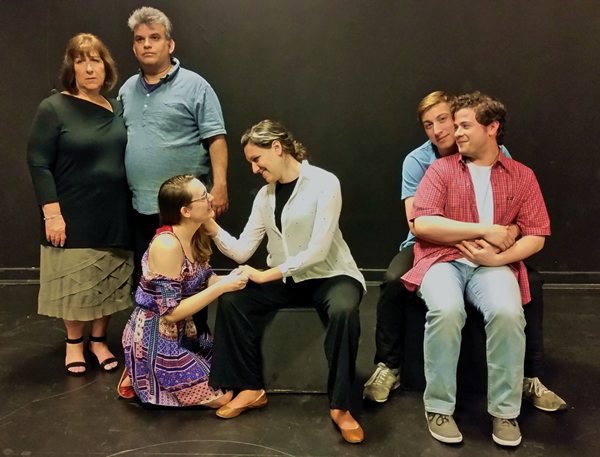
The cast of ‘DOMA Diaries’ featuring Nell Quinn-Gibney, third from left. (Photo courtesy Kevin West)
Other shows to look out for at Capital Fringe include seasoned performer Jeffrey Johnson’s multimedia-drag-production, “A Romp Around Uranus with Special Agent Galactica.”
Johnson, who was the artistic director of the now-defunct, LGBT theater company Ganymede Arts in Washington, is the creator, writer, director and lead performer in the play. Galactica, a lip sync character, was born out of his work with Ganymede.
She became a success and generated a large local following. Johnson has performed as Galactica at almost every gay bar in town.
“A Romp” also features three original songs written by Johnson. Galactica’s spaceship is played by award-winning musician and B-52’s frontman, Fred Schneider.
“This is taking drag performance to a totally different place,” Johnson says. “It’s taking on drag done live, it has clever humor, but, you know, low-brow comedy as well.”
Johnson emphasizes that his production is not a drag show, but a theater piece that uses the elements of drag to enhance the show.
In 2010, Johnson took Galactica from a lip-sync character to a live music songstress and how he says he’s ready for the next chapter in her short, yet eventful life.
“Now, I’m taking her from being just a live cabaret or music show to actually being a theater piece,” Johnson says. “It’s always fun to challenge myself and rethink the presentation of this character and take her into new areas that she hasn’t gone before.”
Another pioneering piece comes from writer, director and professional home and office organizer, Brett Steven Abelman.
Abelman’s play, which he created and directs, is “Play Cupid,” his fourth production at Capital Fringe. The play features five characters that the audience can send on a date. There are two men, two women and one character that identifies as gender-queer.
“Anyone can be paired up with anyone,” says Abelman, a Washington-area native. He likes the component of audience choice in theater, which he says is not common.
Abelman hopes his show can “open little corners” within his audience’s mind by having them go through the process of meeting the characters, getting to know them and pairing them up.
The audience, director and actors will not know, on any given night, who will get sent on a date and who will not. So, as Abelman says, flexibility for everyone involved in “Play Cupid” is important.
“I am thrilled that I found these five collaborators, plus my assistant director and producer,” Abelman says. “The No. 1 thing is getting along with each other and we share stories about dating and romance and all that kind of stuff to help build the show.”
Niusha Nawab, one of the male actors in “Play Cupid,” who graduated from American University in 2015 with a degree in theater arts and audio production, describes the play as “modern” in terms of its LGBT content.
“On the one hand, it’s somewhat of an idealistic alternative reality where the sexuality of all the characters is mostly irrelevant to their lives within the play and isn’t a defining factor of who they are,” Nawab says. “On the other hand, when it does recognize and deal with their sexuality, it does so in specific and useful ways, like the fact that one character is pansexual, not bi, or that the only black character (in the show) has to deal with the intersectionality of being both black and queer in his love life.”
Nawab also emphasizes how gender-queerness plays a role in “Play Cupid.” He says it unfurls in “differing but challenging ways.”
“Our play is a high-scorer on the not-straight-white-cis-dude scale,” Nawab says.
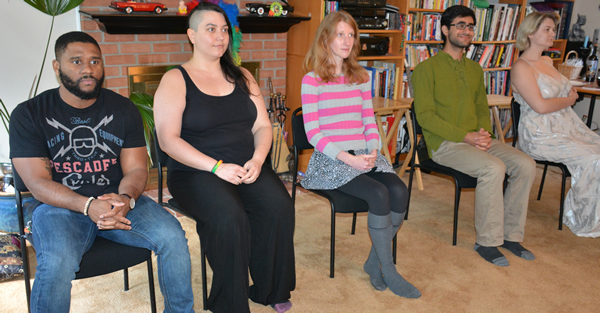
The cast of ‘Play Cupid’ in rehearsal. (Photo by Sonia Zamborsky)
Another LGBT-themed Fringe show is “HUNT: a Political Drama,” written and produced by Jean P. Bordewich and directed by Kristin Shoffner. The play is based on the true story of Sen. Lester Hunt, a Wyoming Democrat, who was blackmailed by Sen. Joe McCarthy’s allies in the Senate over homosexual allegations against his son.
Bordewich, who has spent her life in politics on Capitol Hill as a Senate and House staff member and in Red Hook, N.Y., as a town council member, and as a candidate for Congress and Senate district staffer, says she wanted to explore the dangers of political extremism, demagoguery and homophobia through the lens of the 1950s Cold War era.
“I had no idea when I wrote ‘HUNT,’” she says, “that the rise of a demagogue as a presidential candidate and the massacre at the Pulse nightclub in Orlando would make this history so tragically relevant today.”
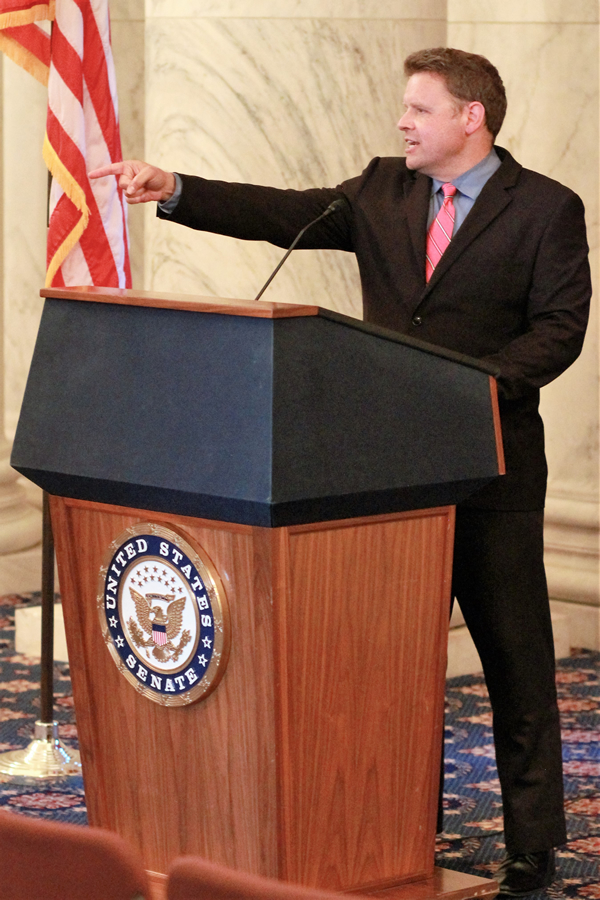
Terry Loveman as Sen. Hunt in ‘HUNT: a Political Drama.’ (Photo courtesy Jean P. Bordewich)
Full details at capitalfringe.org
‘Bryce: Hydrogen Blonde’
Logan Fringe Arts Space: Trinidad Theatre (1358 Florida Ave., N.E.)
Friday, July 8 at 10:15 p.m.
Thursday, July 14 at 7:45 p.m.
Sunday, July 17 at 4:15 p.m.
Friday, July 22 at 9 p.m.
Sunday July 24 at 12:30 p.m.
Tickets are $17
‘The DOMA Diaries’
Flashpoint: Mead Theatre Lab (916 G St., N.W.)
Thursday, July 7 at 6:30 p.m.
Sunday, July 10 at 6:30 p.m.
Friday, July 15 at 8:30 p.m.
Thursday, July 21 at 8 p.m.
Saturday, July 23 at 12:45 p.m.
Tickets are $17
‘A Romp Around Uranus with Special Agent Galactica’
Logan Fringe Arts Space: Upstairs (1358 Florida Ave., N.E.)
Saturday, July 9 at 10 p.m.
Wednesday, July 13 at 8:30 p.m.
Sunday, July 17 at 10 p.m.
Tuesday, July 19 at 9 p.m.
Sunday, July 24 at 6 p.m.
Tickets are $17
‘Play Cupid’
Atlas Performing Arts Center: Lab II (1333 H St., N.E.)
Friday, July 8 at 8:15 p.m.
Sunday, July 10 at 7 p.m.
Friday, July 15 at 10:30 p.m.
Thursday, July 21 at 6 p.m.
Sunday, July 24 at 6:30 p.m.
Tickets are $17
‘HUNT: A Political Drama’
Flashpoint: Mead Theatre Lab (916 G St., N.W.)
Thursday, July 7 at 8:45 p.m.
Wednesday, July 13 at 6:45 p.m.
Saturday, July 16 at 2:30 p.m.
Tuesday, July 19 at 8:45 p.m.
Friday, July 22 at 6:45 p.m.
Sunday, July 24 at 2:15 p.m.
Tickets are $17
a&e features
Have yourself a merry John Waters Christmas
Annual holiday show returns to Alexandria and Baltimore
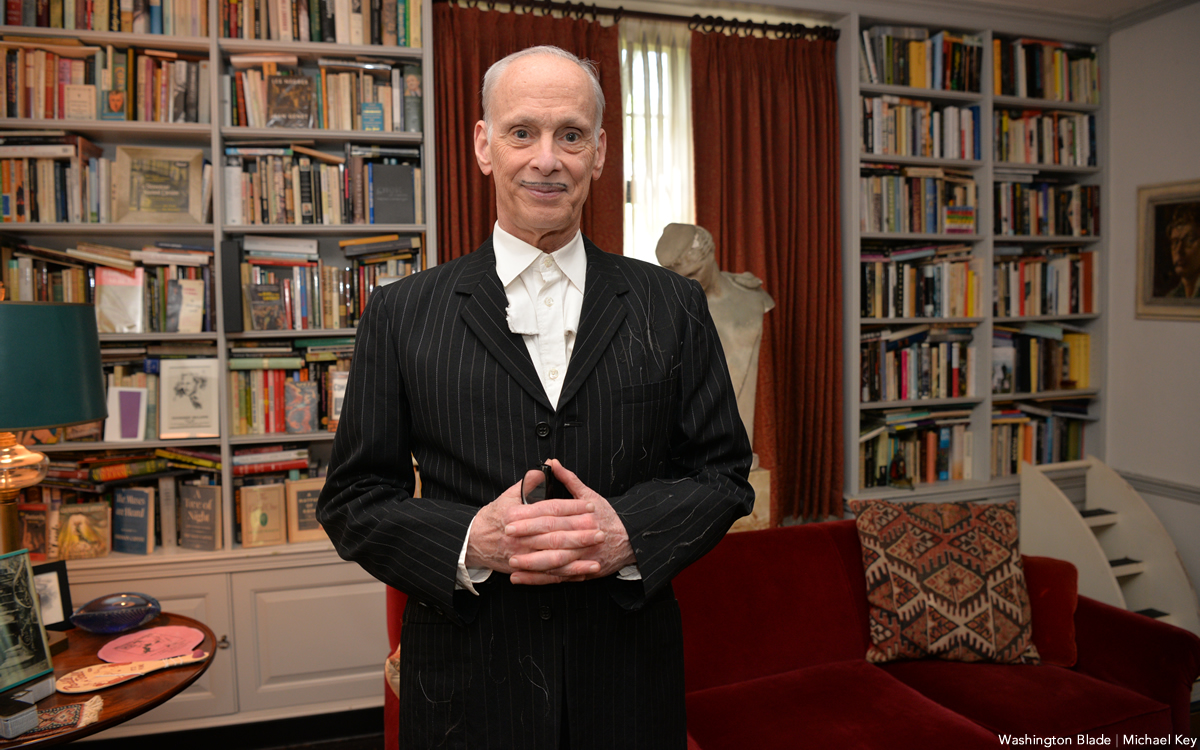
When it comes to iconic Christmas scenes in movies, none can top the tree-toppling tantrum thrown by cha-cha heels-deprived Dawn Davenport in John Waters’s fifth full-length feature “Female Trouble” from 1974. Therefore, it’s not surprising that Waters continues to make art out of Christmas, performing his spoken word Christmas tour in cities across the country. Waters has even more reason to celebrate with the release of his new red vinyl 7” single, a cover of Little Cindy’s “Happy Birthday Jesus (A Child’s Prayer)” on the A-side, and “A Pig Latin Visit From St. Nicholas” on the B-side. If you’re still looking for unique Christmas gifts, consider this record. As always, John was kind enough to make time for an interview in advance of his tour dates.
BLADE: John, in preparation for this interview with you, I went back and listened to Little Cindy’s original rendition of “Happy Birthday Jesus (A Child’s Prayer)” on your “A John Waters Christmas” CD.
JOHN WATERS: One thing I did, if you notice, I make the same stumble in my recording that she did in the original.
BLADE: It sounded to me like she got choked up.
WATERS: No, I think she just stumbles over a word, so I stumbled over the same word. It’s appropriation, insanely.
BLADE: Is this a song you first became aware of in your youth or when you were an adult?
WATERS: When I was doing the Christmas album, I had this friend named Larry Benicewicz. He was kind of my idea man with music. He knew every single old record. I would say to him, “Weird Christmas songs,” when we were doing a soundtrack, or a song about bears, or a song about this, and he would give me all these tapes. It was one of the ones he played for me. A lot of the songs I put in my movies and on my records, I did know as a kid. I did not know this one, but I immediately embraced it. I don’t think it’s campy. I think it really is spiritual in a weird way. My doing it makes it a novelty record. I am really for novelty records, and there aren’t any anymore. Why was there not a COVID novelty record? That’s insane. The dance “The Bug” that’s on the “Hairspray” soundtrack would be perfect for COVID.
BLADE: The thing that struck me was that for a Christmas song in the voice of a child, a kind of death pall hangs over it, with lines like, “If I was good you’d let me live with you” and “they nailed you to the cross, they wanted you to die.”
WATERS: All of it! When I see children at midnight mass kneeling in front of a nude man nailed to a cross, I feel like I’m at The Eagle! It is S&M, it’s creepy. I took the same cover (photo) from her record to parody and put my face on it. The same thing I did with The Singing Dogs last year when I covered (their version of) “Jingle Bells.” I’m really into novelty records. I love them and I’m trying to bring them back. I don’t expect anybody to ever play these records. Even The Singing Dogs one said on it, “Please do not play this record” [laughs]. And the flipside, the Pig Latin version, is almost impossible to listen to.
BLADE: I’m so glad you mentioned that. “A Pig Latin Visit From St. Nicholas” reminded me of the lost art of speaking in Pig Latin. I also recall watching the PBS series “Zoom” as an adolescent and learning to speak “ubbi dubbi,” a distant relative of Pig Latin. Do you think that the time is right for a Pig Latin or ubbi dubbi revival?
WATERS: Here’s the thing, I never could pick up any language, except Pig Latin. I’ve been in every foreign country. Foreign countries have given me money to learn to speak the language. I can never do it! But Pig Latin…my parents and other parents in the ‘50s spoke Pig Latin so kids couldn’t understand what they were saying. Then my mother taught it to me, and I used it. The hardest take to shoot in “Pink Flamingos” was not eating the dog shit. It was when the cast skipped, in one take, saying “E-way, are-yay e-they ilthiest-fay eople-pay in-hay e-they ole-hay ide-way orld-way.” We’re the filthiest people in the whole wide world in Pig Latin. We had to do so many takes so they could do it once without screwing it up. In “Polyester,” Edith (Massey) answers the phone, “ello-hay.” I did a photo piece where it was all subtitled in Pig Latin. Like “osebud-Ray” (from “Citizen Kane”) or in “Streetcar,” “ella-Stay!” [Laughs] All the iconic dialogue translated into Pig Latin. My assistant who helped me do it, had never heard of Pig Latin. She really got good at it because she lived in many foreign countries and can pick up languages. But it’s not that easy to do it correctly and read it. Your computer will translate into Pig Latin.
BLADE: AI understands Pig Latin?
WATERS: I guess that’s AI. It wasn’t 100% right, but it was close. I can speak it if I look at it, but just do a bit at a time. It was a challenge that no one would possibly care about or want to do.
BLADE: I think you pulled it off very well.
WATERS: If you want people to leave on Christmas morning, you put it on. That’s how you get your guests to leave. It’s time to go.
BLADE: Ood-gay i-bay! How did your relationship with record label Sub Pop, which released 2021, 2022, 2024, and new 2025 holiday singles, come about?
WATERS: I believe the first thing I did for them was “Prayer to Pasolini.” They came to me through Ian Brennan. He’s won a couple Grammys for World Music, but he is also is one of my agents who does the Christmas tour and a lot of my shows, anything with music. He helped me arrange each one of the songs. He had a relationship with Sub Pop. It was perfect. My friends in Baltimore, (the band) Beach House, have had huge success.
BLADE: That’s right, they’re on Sub Pop!
WATERS: Yes! I’m happy to be on it. I’ve even been to the warehouse and posed for pictures like Jackie Suzanne used to do.
BLADE: Is there any chance that “A John Waters Christmas” might be reissued on vinyl by Sub Pop?
WATERS: No. It’s such a nightmare to get the rights and to renew them. You have to find the publisher and the writer, and they usually hate each other. It doesn’t matter if it’s obscure or famous, it’s hard to get. You have to make the deal. The singer doesn’t get anything unless they play it on the radio. It would be so complicated legally, and there would be such a [laughs] tiny audience for it. I hope it will come out again. The same thing with the one for Valentine’s Day. I had two of them that did quite well when they came out; “A Date With John Waters and “A John Waters Christmas.” The “John Waters Christmas” album is still the soundtrack that plays whenever I’m doing my spoken word Christmas show as people are entering the theater.
BLADE: Aside from your annual Christmas show tour, what else do you do for the holidays now, and are there any traditions that you’ve carried over from your family?
WATERS: Certainly! I have two sisters, my brother’s widow, and me, so there are four and we take turns each year to have the Christmas dinner. Mine was last year. An entire sit-down dinner. Mom’s China, the silverware, the entire full dinner. It’s pretty traditional. I don’t have a Christmas tree, but I do decorate the electric chair from “Female Trouble.” That is a tradition in my family. We do have Christmas decorations, but they’re usually weird ones that fans sent me. I have one with Divine knocking over the Christmas tree, and the Christmas tree lights up, all sorts of amazing things. There is definitely a tradition here that might be a little altered, but it is definitely a tradition. I used to have a giant party every year, but COVID ended that. I still wouldn’t want 200 people in my house breathing right now.
BLADE: I was looking at your tour schedule and wondered if there are any new cities in which you’ve never performed the John Waters Christmas show that have been added to this year’s schedule?
WATERS: I don’t think there’s a city in America in which I haven’t done one show! The only places I haven’t been to are Hawaii and Alaska. I could do it there, but it’s too long on a tour. I can’t think of a city I haven’t played in in America over the last 50 years. The Christmas show is completely different every year. It doesn’t matter if you saw it last year.
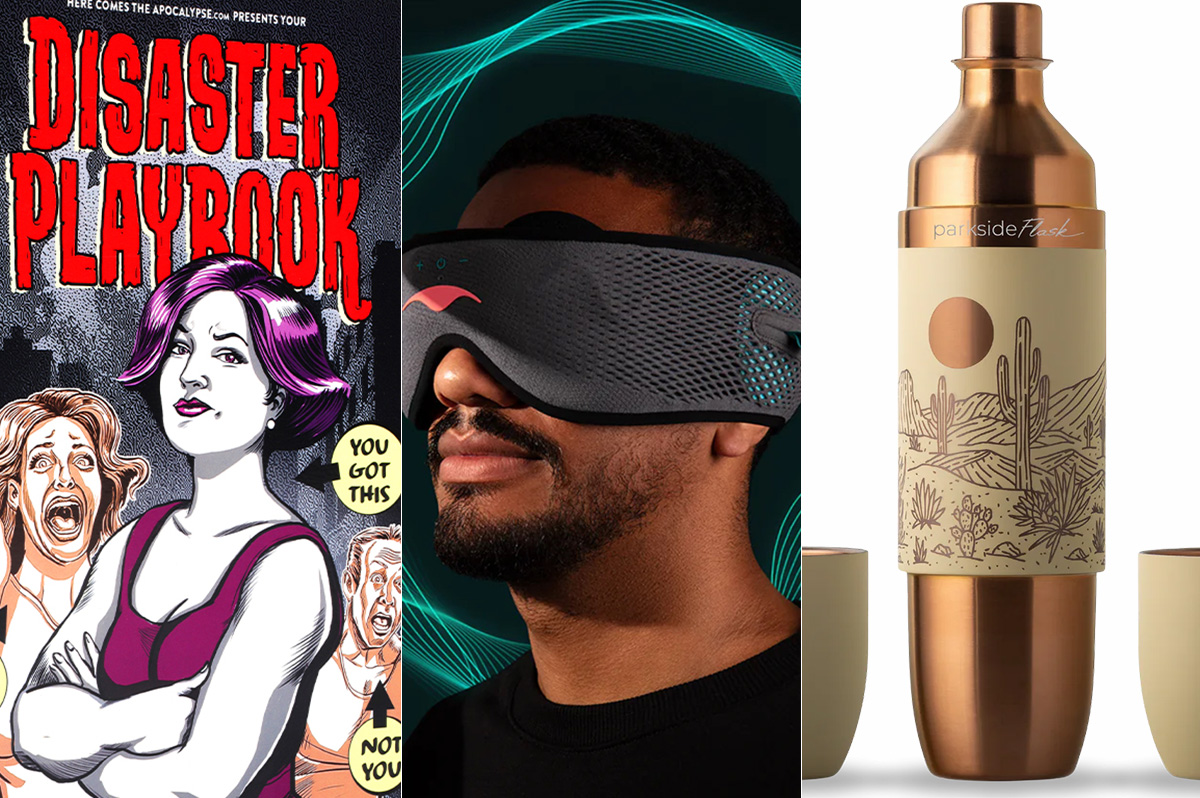
Some gifts scream practical, others whisper luxury, and a few flat-out blur the lines. From cocoa that feels ceremonial to a cologne that linger like a suggestive smirk, this year’s ultimate gift picks prove that thoughtful (and occasionally naughty) presents don’t have to be prosaic. Welcome to your holiday cheat sheet for festive tangibles that get noticed, remembered, and maybe even result in a peck of gratitude planted under the mistletoe. Consensually, of course.
Amber Glass Champagne Flutes
Pop the champs – but make it vintage. These tulip-shaped stunners in amber-tinted glass bring all the Gatsby vibes without the Jazz-age drama. Whether you’re toasting a milestone or celebrating a Tuesday, their seven-ounce capacities and hand-wash-only care make ‘em as practical as they are pretty. Pair with a thoughtful bottle of bubs and gift with a glittering wink. $18, NantucketLooms.com
Disaster Playbook by Here Comes the Apocalypse
Because the end of the world shouldn’t be a solo act, this spiral-bound guide is your step-by-step roadmap to surviving and thriving when everything else goes sideways, which might be sooner than you think. Packed with checklists, drills, and a healthy dose of humor, it’s like a survival manual written by your most prepared (and slightly snarky) friend. Whether you’re prepping for a zombie apocalypse or, more realistically, REVOLUTION!, this playbook’s got your back. $40, HereComesTheApocalypse.com
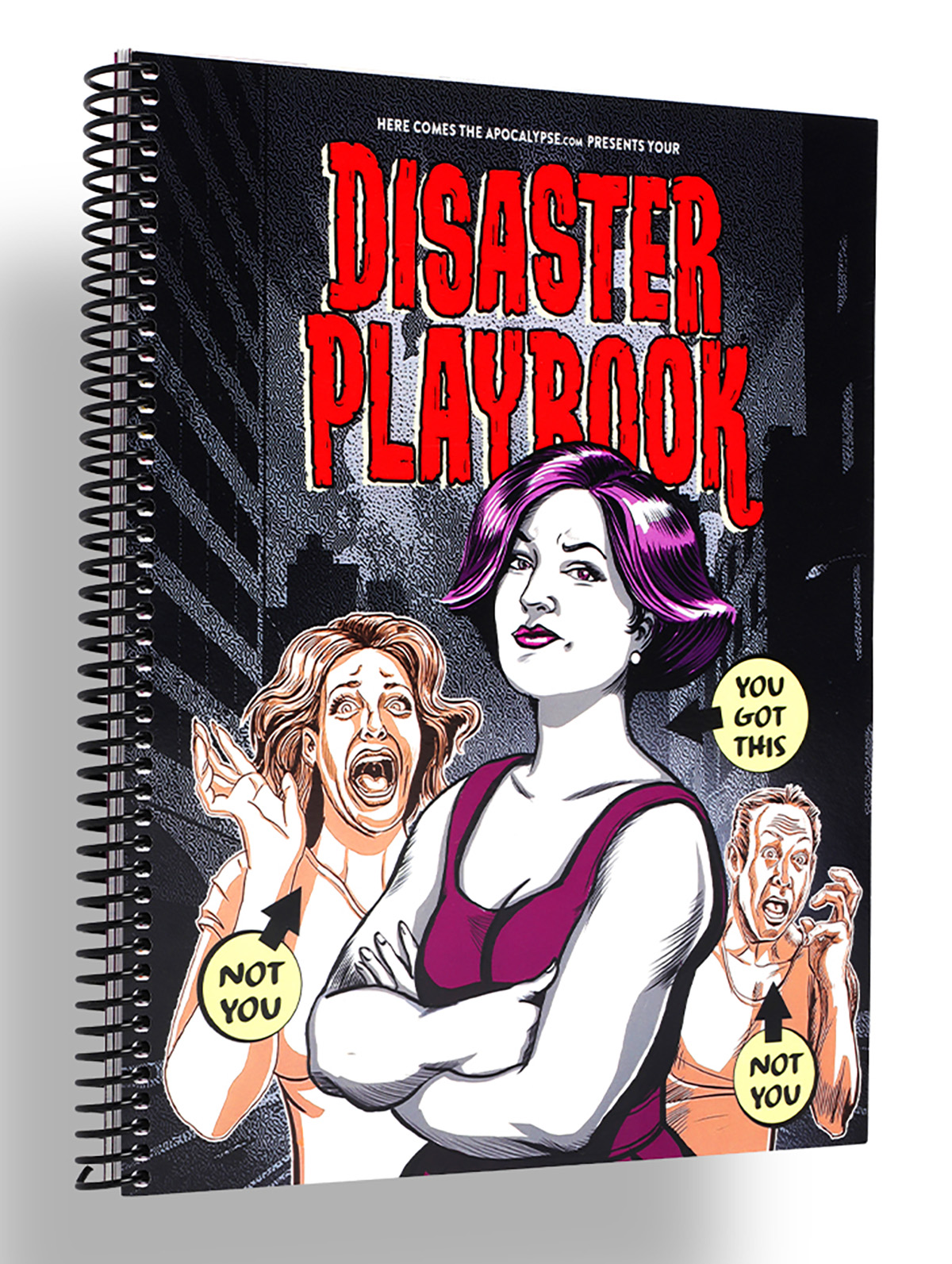
Wickless Vulva Candles
Bold, luxurious, and completely flame-free, CTOAN’s wickless candles melt from beneath on a warmer, releasing subtle, sophisticated fragrances, like sandalwood or lavender. The vulva-shaped wax adds a playful, provocative element to any space –perfect for a bedroom, living room, or anywhere you want elegance with an edge. A gift that celebrates form, intimacy and self-expression, no fire required. $39, CTOANCO.com
Villeroy & Boch Royal Classic Christmas Collection
Every meal is a mini celebration – with whimsy at every place setting – in Villeroy & Boch’s Royal Classic festive dinnerware collection that hits all the right notes. Made from premium German porcelain, it features nostalgic little toys, nutcrackers, and rocking horses in delicate relief, giving your holiday spread a playful but refined twist. Dishwasher- and microwave-safe, it’s luxe without the fuss. Gift a piece to a special someone, or start a collection they’ll use (and show off) for years to come. $22-$363, Villeroy-Boch.com
Greenworks Electric Lawnmower
You a ’hood queen who considers lawn care performance art – or just wants to rule the cul-de-sac in quiet, emission-free glory? Greenworks’ zero-turn electric mower has the muscle of a 24-horsepower gas engine but none of the fumes, drama or maintenance. Six 60V batteries and a 42-inch deck mean you can mow up to two-and-a-half acres on a single charge – then plug in, recharge, and ride again. It’s whisper-quiet, slope-ready, and smooth enough to make you wonder why you ever pushed anything besides your queer agenda. The perfect gift for the homeowner who loves sustainability, symmetry, and showing off their freshly striped yard like that fresh fade you get on Fridays. $5,000, GreenworksTools.com
Molekule Air Purifier
For the friend who treats their space like a sanctuary (or just can’t stand sneezes), the Molekule Air Pro is magic in motion. Covering up to 1,000 square feet, it doesn’t just capture allergens, VOCs, and smoke – it destroys them, leaving your air feeling luxury-clean. FDA-cleared as a Class II medical device, it’s serious science disguised as modern design. Gift it to your city-dwelling, pet-loving, candle-burning friend who likes their living room as pristine as their Instagram feed. $1,015, Molekule.com

Cipriani Prosecco Gift Set
Effervescent with stone-fruit sweetness and a touch of Italian flair, the Cipriani Bellini & Prosecco gift set brings brunch-level glamour to any day of the week. The Bellini blends rich white-peach purée with sparkling wine, while the dry ’secco keeps things crisp and celebratory. Pop a bottle, pour a flute, and suddenly winter weeknights feel like a party – even with your pants off. $36, TotalWine.com
Woo(e)d Cologne
British GQ recently crowned Woo(e)d by ALTAIA the “Best Date Night Fragrance,” and honestly, they nailed it. Confident without being cocky – smoky gaïac and Atlas cedarwood grounds the room while supple leather and spicy cardamom do all the flirting – it’s a scent that lingers like good conversation and soft candlelight. Gift it to the one who always turns heads – or keep it for yourself and let them come to (and then on) you. $255, BeautyHabit.com
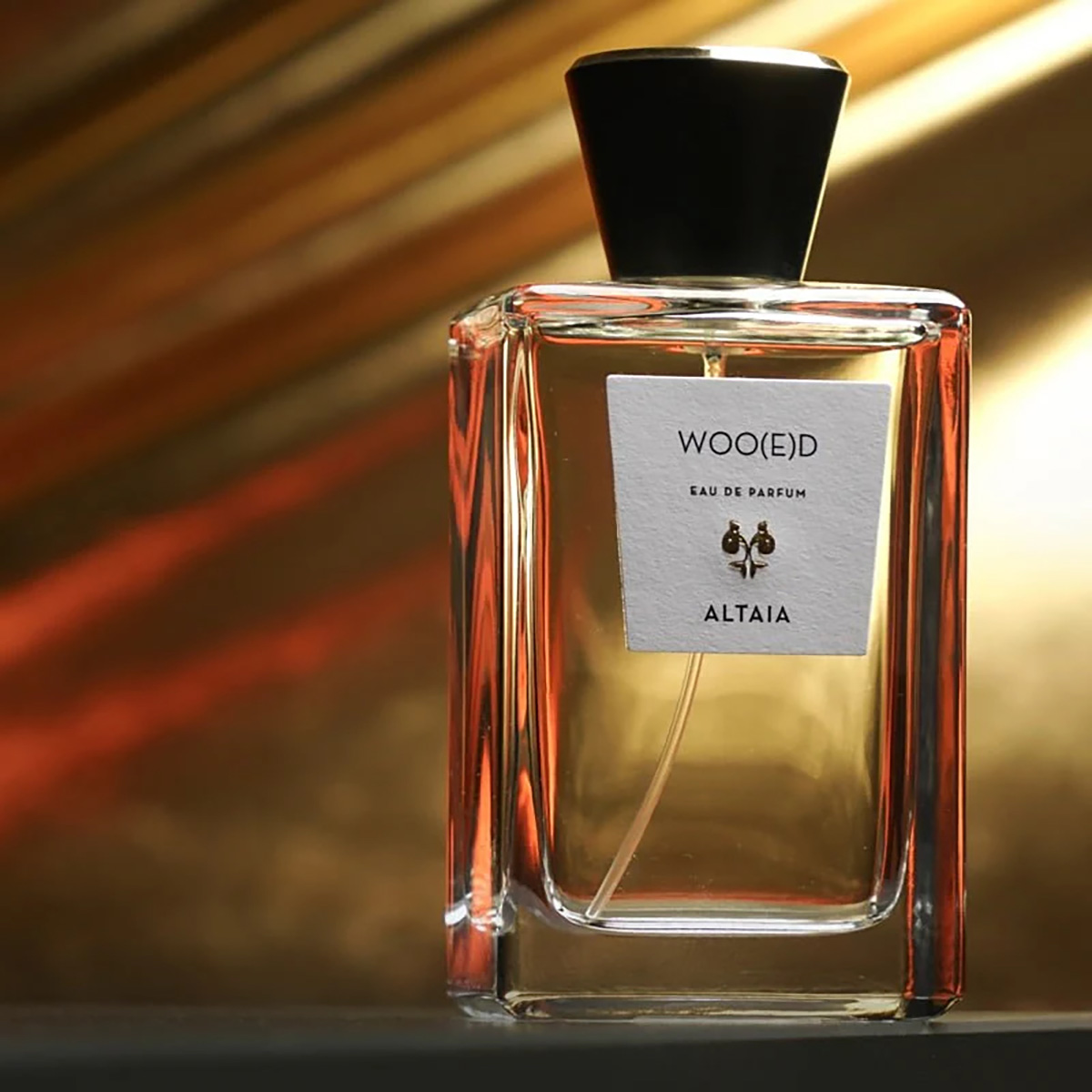
Lococo Cocoa Kit
Keep the run-of-the-mill mugs in the cabinet this Christmas and pull out Lococo’s handcrafted Oaxacan versions that demand you slow down and sip like it matters. Paired with a wooden scoop, rechargeable frother, and Lococo’s signature spice hot-chocolate blend (vegan, gluten-free, with adaptogenic mushrooms), this holiday kit turns Mexi-cocoa into a mini ritual you’ll look forward to. Perfect for anyone who loves a little indulgence with a side of ¡A huevo! energy.
Manta Sleep Mask
Total blackout, zero pressure on the eyes, and Bluetooth speakers built right into the straps, this ain’t your mama’s sleep mask — but it could be. The Manta SOUND sleep mask features C-shaped eye cups that block every hint of light while ultra-thin speakers deliver your favorite white noise, meditation, or late-night playlist straight to your ears. With 24-hour battery life, breathable fabric, and easy-to-adjust sound, it turns any bed (or airplane seat) into a five-star sleep suite. Perfect for anyone who treats shut-eye like an art form (or just wants to escape their roommate’s late-night bingin’ and/or bangin’). $159, MantaSleep.com

Shacklelock Necklace
Turn the industrial-chic vibe of a shackle into a sleek statement. Mi Tesoro’s platinum-plated stainless-steel necklace sits on an 18-inch wheat chain, featuring a shackle-style latch pendant that’s waterproof, tarnish-free, and totally fuss-les. Beyond style, it nods to a classic gesture in the queer leather community: replacing a traditional Master lock with something elegant to quietly signal belonging to someone special. Wear it solo for a minimalist edge or layer it like you mean it; either way this piece locks in both your look and your intentions. $90, MiTesoroJewelry.com
Parkside Flask Mojave Edition
Wine nights get a desert glow-up with Parkside’s limited-edition 750-milliliter all-in-one flask draped in sun-washed bronze and badland hues like sage, sand, and terracotta – with magnetic stemless tumblers that snap on for effortless shareability. It keeps your vino chilled for 24 hours, pours without drips (no tears for spilled rosé, please), and even lets you laser-engrave your own mantra or inside joke. Perfect for picnics, surprise rooftop clinks, or gifting to your favorite wine (or desert) rat. $149, HighCampFlasks.com
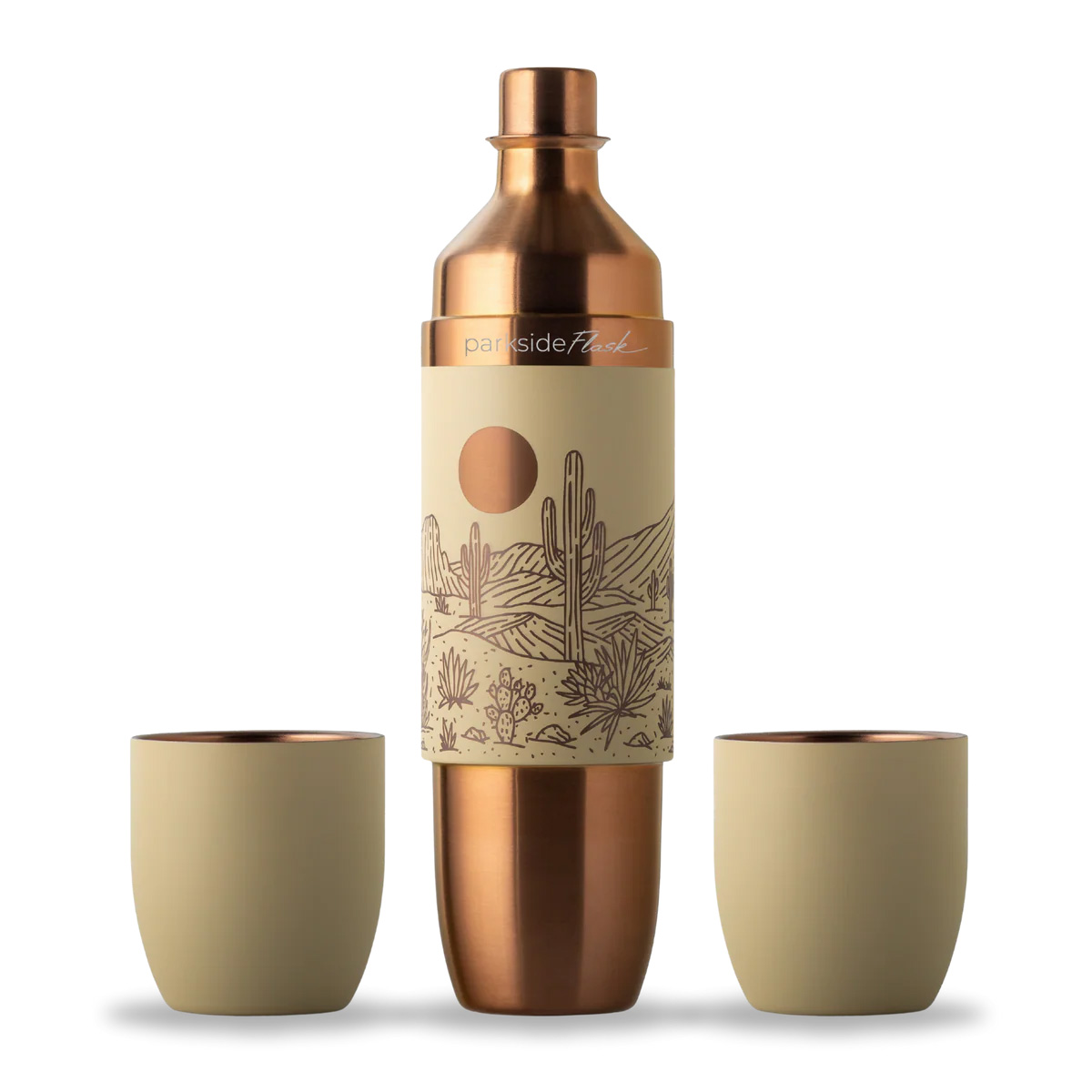
Mikey Rox is an award-winning journalist and LGBT lifestyle expert whose work has published in more than 100 outlets across the world. Connect with him on Instagram @mikeyroxtravels.
a&e features
Meet Mr. Christmas
Hallmark’s Jonathan Bennett on telling gay love stories for mainstream audiences
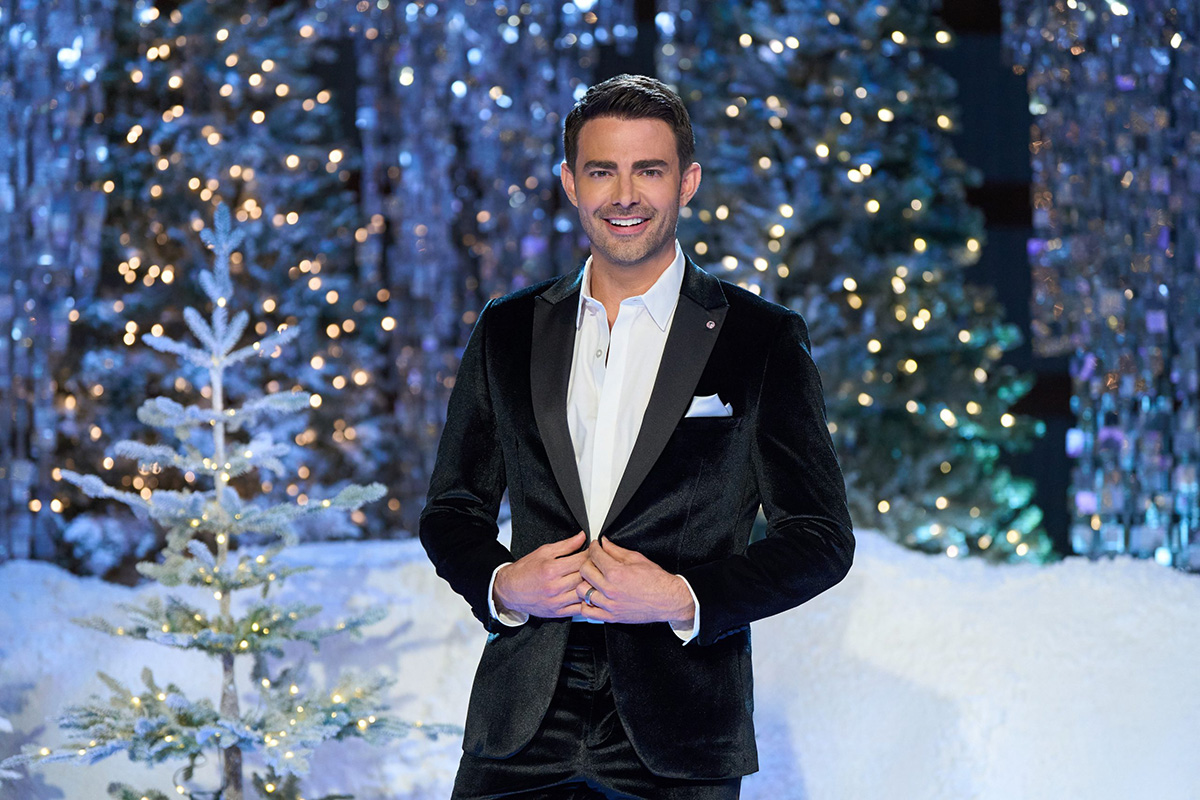
Jonathan Bennett believes there are two kinds of people in the world — those who love Hallmark movies and liars. And in Season 2 of Finding Mr. Christmas, which the Mean Girls star co-created with Ben Roy, Bennett is searching for Hallmark’s next leading man.
“It’s so fun for people because everyone in their life has someone they know that they think should be in Hallmark movies, right? The UPS driver, the barista at the coffee shop, the dentist,” Bennett says. “So we’re testing their acting abilities, we’re testing who they are, but we’re also looking for that star quality — the thing that makes them shine above everyone else. It’s almost something you can’t explain, but we know it when we see it.”
Season 2’s cast includes a former NFL player for the Green Bay Packers, a few actors, and a realtor. The 10 men compete in weekly festive-themed acting challenges, one of which included having to ride a horse and act out a scene with Alison Sweeney. The contestants were chosen from a crop of 360 potential men, and Bennett gives kudos to the show’s Emmy-nominated casting director, Lindsay Liles (The Bachelor, Bachelor in Paradise).
“She has a tough job because she has to find 10 guys that are going to be good reality television, but also have the talent to act, carry a scene, and lead a Hallmark movie eventually,” he says. To be the right fit for a Hallmark leading man, Bennett singles out five key characteristics: you have to be funny, charming, kind, have a sense of humor, and you have to do it all with a big heart.
Of course, Finding Mr. Christmas wouldn’t be Finding Mr. Christmas without its signature eye candy — something Bennett describes as “part of the job” for the contestants. “I can’t believe Hallmark let me get away with this. I dressed them as sexy reindeer and put them in harnesses attached to a cable 30 feet in the air, and they had to do a sexy reindeer photo shoot challenge,” he says with a laugh. “This season is just bigger and bolder than last. People are responding to not only all the craziness that we put them through, but also comparing and contrasting the guys in their acting scenes when we do them back-to-back.”
Season 1 winner Ezra Moreland’s career has been an early testament to the show’s success at finding rising talent. On seeing the show’s first winner flourish, Bennett says, “Now to watch him out in the world, just booking commercial after commercial and shining as an actor and a model, I think the show gave him the wings to do that. He learned so much about himself, and he took all that into his future auditions and casting. He just works nonstop. I’ve never seen an actor book more commercials and modeling gigs in my life.”
Bennett has been a star of plenty of Hallmark movies himself, including the GLAAD-award-winning The Groomsmen: Second Chances, which makes him a fitting host. Among those movies are 2020’s Christmas House, which featured the first same-sex kiss on the network and had a major impact on Bennett’s career as an openly gay man. “Hallmark’s been so great about supporting me in queer storytelling. But again, I don’t make gay movies for gay audiences. I make gay love stories for a broad audience, and that’s a huge difference, right? We’re not telling stories inside baseball that only the gay community will understand.”
He continues, “The backdrop of a Hallmark Christmas movie is very familiar to these people who watch. And so when you tell a gay love story, and you tell it no differently than a straight love story in that space, they’re able to understand. It’s able to change hearts and minds for people who might not have it in their lives.”
While Hallmark has become a major staple of Bennett’s career, he started off wanting to be a Broadway actor. And before the first season of Finding Mr. Christmas aired, Bennett took a break from TV to make his Broadway debut in Spamalot, replacing Michael Urie as Sir Robin and starring alongside Ethan Slater and Alex Brightman.
“That was my dream since I was five years old – then I booked a movie called Mean Girls, and everything kind of changes in your life. You no longer become a person pursuing Broadway, you become a part of pop culture,” Bennett recalls. “And to be honest, when I hit 40, I was like, ‘I’m probably never going to get to live that dream.’ And that’s okay, because I got to do other dreams and other things that were just as cool but different. So I honestly never thought it would happen.”
Bennett is still determined to make his way back on Broadway with the right role — he calls Spamalot the “best experience” of his life, after all — but he’s got another Hallmark show lined up with Murder Mystery House, which he co-created. The show was recently greenlit for development and intends to bring the Hallmark mystery movie to life. “It’s kind of like our version of The Traitors,” Bennett admits.
Looking back on both seasons, Bennett says that what makes Finding Mr. Christmas stand out in the overcrowded reality TV landscape is that everyone involved makes it with heart: “This isn’t a show where you’re going to watch people throw drinks in each other’s faces and get into big fights. The thing that has amazed me so much about this show, the more we’ve done it, is that every season, 10 guys come in as competitors, but they leave as a family and as brothers. That’s something you don’t get on any other network.”
Finding Mr. Christmas airs every Monday on Hallmark through December 20, with episodes available to stream on Hallmark+.


